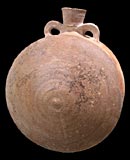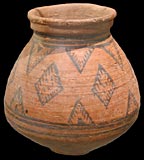The three kingdoms
Three separate states arose in the 6 th century AD in the territory
of today's northern Sudan. In Lower Nubia, it was the kingdom of Nobatia
with its capital in Faras, bordering with Makuria (modern Dongola Reach)
in the south, while on the Blue Nile grew the kingdom of Alwa with
the city of Soba as its centre. Political prudence made the rulers
of the Nubian kingdoms, who closely followed the situation in Byzantine
Egypt and Christianized Ethiopia, adopt the ruling religion of the
Empire - Christianity.
Under the sign of the Cross

About 543 AD the ruler of Nobatia received baptism in the Monophisyte
confession (one of the two factions of the contemporary Church) from
the priest Julian. This fact coincided with closure of the last Egyptian
temple on Philae island by the emperor Justinian, and so both dates mark
the symbolic end of antiquity on the Nile. The Christianization of Nubia
was continued by Longinus, who in 580 converted the inhabitants of the
kingdom of Alwa. Several years earlier the religion had been adopted
by Makuria, then in open military conflict with its neighbours. At the
beginning of the 8 th century, the kingdom of Makuria managed to assimilate
Nobatia and thus created a huge state which was to go through a period
of political and cultural prosperity over the next centuries.
Kings and saints from Locust Island

One of the most famous discoveries over the recent years has been
brought by the explorations carried out by Polish archaeologists at
Banganarti (
Locus Island in the local dialect). The
central point of the immense complex of buildings encircled by walls
and turrets was a large church on the plane of the cross, originally
on the plane of the cross, originally covered with a dome. On the eastern
side the church was adjoined by a row of chapels whose walls were covered
with murals of exceptional quality, often in layers put one upon the
other over centuries. The repeat the analogous compositional scheme:
one of the Archangels blesses in a symbolic gesture a Nubian ruler
in ceremonial dress, accompanied by the twelve apostoles.
In the Middle Ages the church might have functioned as a royal mausoleum
functioned as a royal mausoleum for the members of the dynasty ruling
in nearby Old Dongola. At its prime Banganarti must have been one of
the most important religious centers in Nubia, regularly visited by
crowds of pilgrims who left hundreds of inscriptions and graffiti on
the building's walls.
Islam
The Arabs, who conquered Egypt in the 7 th century, made two unsuccessful
attempts to invade Nubia. The peace treaty (in Arabic sources:
baqt)
that was concluded in 652 guaranteed Nubian independence and freedom
in exchange for an annual tribute of slaves and a promise to erect a
mosque at Dongola. Over the next centuries Makuria had regular diplomatic
relations with the Arab world. The situation changed only in the 12 th
century. This was a time of unrest in Nubia, witnesses by the construction
of numerous forts. The northern kingdom of Makuria practically collapsed
in 1323 and was taken over by a new Arab dynasty of the Beni Kanz tribe.
In the south, Alwa survived for nearly two hundred years, constantly
attacked by Arab Bedouin and finally conquered by a Muslim ruler of the
Funj people. The green banner of Islam appeared over the Sudan...

